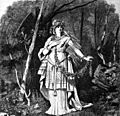Folkvang facts for kids
Folkvanger (pronounced FOHL-kvahng-er) is a special place in Norse mythology. It is the home of the powerful goddess Freyja. The name "Folkvanger" means "Field of the Folk." In this case, "folk" refers to brave warriors who have fallen in battle.
Contents
What is Folkvanger?
Folkvanger is one of the most important places in the Norse cosmos. It is a beautiful realm where Freyja welcomes half of the warriors who die bravely in combat. The other half go to Valhalla, the hall of Odin. Folkvanger is often described as a peaceful and glorious field, a fitting resting place for heroes.
Freyja's Hall: Sessrúmnir
Within Folkvanger, Freyja has her magnificent hall called Sessrúmnir (pronounced SESS-room-neer). This name means "Seat-room" or "Many-seated." It is here that the chosen warriors live after their death. They are believed to continue a life of honor and feasting, much like in Valhalla.
Who is Freyja?
Freyja is one of the most important goddesses in Norse mythology. She is known for many things, including love, beauty, fertility, war, and even magic. She is a member of the Vanir, a group of gods associated with nature and prosperity.
Freyja's Role in Battle
Freyja is not just a goddess of love; she is also a fierce warrior goddess. She rides into battle on her chariot pulled by two large cats. After a battle, she has the first choice of the fallen warriors. This shows her high status and power among the Norse gods. She chooses half of the bravest warriors to join her in Folkvanger.
Life in Folkvanger
Life in Folkvanger for the chosen warriors is believed to be a continuation of their honorable existence. They are welcomed by Freyja herself and live in her grand hall, Sessrúmnir. While the exact details are not as widely described as life in Valhalla, it is understood to be a place of honor, feasting, and preparation for the final battle of Ragnarök.
Why Two Afterlives for Warriors?
The idea of warriors going to both Folkvanger and Valhalla shows the different aspects of Norse beliefs about death and honor. It highlights the importance of both Freyja and Odin in the afterlife. Some scholars believe it might also reflect different traditions or beliefs about the afterlife that existed in ancient Norse cultures.
Images for kids
See also
 In Spanish: Fólkvangr para niños
In Spanish: Fólkvangr para niños



